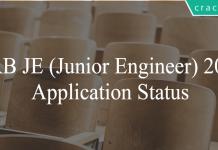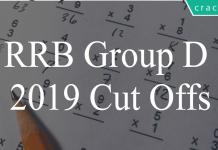RRB Group-D Data Sufficiency Questions PDF
Download Top 15 RRB Group-D Data Sufficiency Questions and Answers PDF. RRB Group-D Data Sufficiency questions based on asked questions in previous exam papers very important for the Railway Group-D exam.
Download RRB Group-D Data Sufficiency Questions PDF
Download RRB Group-D Previous Papers PDF
Take a RRB Group-D free mock test
Question 1: Are the two triangles ABC and PQR similar to each other?
Statement 1: AB = PQ and BC = RQ
Statement 2: angle B = angle P = 90 degrees
a) The question can be answered by using one of the statements alone but not by using the other statement alone
b) The question can be answered by using either statement alone
c) The question can be answered by using both the statements together
d) The question cannot be answered even by using both the statements
Question 2: n ( > 4 ) kids are standing in a line one next to the other, such that everybody is facing north. How many kids are there?
Statement 1: Number of ways in which 3 kids can be selected such that no two selected kids are standing next to each other is 10.
Statement 2: If the kids are made to sit around a circular table such that one particular kid always occupies a specific seat, the number of such arrangements possible is 120.
a) The question can be answered by using statement 1 alone but not by using statement 2 alone
b) The question can be answered by using statement 2 alone but not by using statement 1 alone
c) The question can be answered by using either statement alone
d) The question cannot be answered even by using both the statements
Question 3: Two cars A and B are headed towards each other. What is the ratio of speed of car A to speed of car B?
Statement 1: One second before they collide, the cars are 12m apart.
Statement 2: The speeds of the cars are prime numbers.
a) The question can be answered by using statement 1 alone but not by using statement 2 alone
b) The question can be answered by using statement 2 alone but not by using statement 1 alone
c) The question can be answered by using both the statements together
d) The question cannot be answered even by using both the statements
Take a free mock test for RRB Group-D
770 Mocks (cracku Pass) Just Rs.199
Question 4: If a, b and k are integers, what is the remainder obtained when $a^{2k} + b^{2k+1}$ is divided by 2?
Statement 1: 5a+3b is odd
Statement 2: a*b is odd
a) The question can be answered by using one of the statements alone but not by using the other statement alone
b) The question can be answered by using either statement alone
c) The question can be answered only by using both the statements together
d) The question cannot be answered even by using both the statements
Question 5: A set contains 4 unique positive integers who sum is 40. What is the value of the sum of the squares of all the elements of the set?
Statement 1: The four integers are in an arithmetic progression.
Statement 2: The difference in the squares of the largest and smallest numbers is less than 125.
a) The question can be answered by using statement 1 alone but not by statement 2 alone
b) The question can be answered by using statement 2 alone but not by statement 1 alone
c) The question can be answered by using both the statements together, but not by any individual statement.
d) The question cannot be answered even by using both the statements
Question 6: For integers a and b, is $a^2 + 2ab + b^2$ even?
1) a + 2b is even
2) a*b is odd
a) If the question can be answered by one of the statements alone but not by the other statement alone
b) If the question can be answered by either statement alone
c) If the question can be answered by both the statements together but not by any statement alone
d) If the question cannot be answered by both the statements together
RRB Group D previous year papers
Question 7: By how much is Amit’s salary more than Ajit’s?
1) Ajit’s salary is 20% more than Sharath’s salary and Amit’s salary is 16.67% more than Ajit’s salary.
2) Salaries of Amit, Ajit and Sharath are in AP.
a) If the question can be answered by one of the statements alone but not by the other statement alone
b) If the question can be answered by either statement alone
c) If the question can be answered by both the statements together but not by any statement alone
d) If the question cannot be answered by both the statements together
Question 8: A tank has 3 pipes attached to it. Find the time taken to fill an empty tank if all three pipes are open.
1) Operating alone, each pipe takes the same time to fill the tank.
2) When two pipes are open and the third pipe is closed, the tank is filled in 3 hours.
a) If the question can be answered by one of the statements alone but not by the other statement alone
b) If the question can be answered by either statement alone
c) If the question can be answered by both the statements together but not by any statement alone
d) If the question cannot be answered by both the statements together
Question 9: The profit obtained by selling 3 products at 10% more than the selling price is equal to the loss obtained by selling 7 products at 10% lesser than the selling price. What is the cost price of the product?
Statement 1: The ratio of selling price to cost price is 25:24.
Statement 2: The profit percentage when the product is sold at selling price is 4(1/6)%.
Choose the correct option.
a) The question can be answered using the first statement alone but not by the second statement alone.
b) The question can be answered using the second statement alone but not by the first statement alone.
c) The question can be answered by using both the statements together but not by using either statement alone.
d) The question cannot be answered even by using both the statements together.
Question 10: The ages of 5 boys are distinct natural numbers. The sum of the ages is 30 years. What is the age of the oldest boy?
Statement 1: The sum of the ages of the youngest and oldest boy is 19 years.
Statement 2: The youngest boy is at least 4 years old.
Choose the correct option.
a) The question can be answered using the first statement alone but not by the second statement alone.
b) The question can be answered using the second statement alone but not by the first statement alone.
c) The question can be answered by using both the statements together but not by using either statement alone.
d) The question can be answered by using either statement alone.
RRB Group-D Important Questions (download PDF)
Question 11: Is C positive?
Statement 1: A,B,C,D and E are consecutive terms of an arithmetic progression.
Statement 2: A > |E|
a) The question can be answered using one of the statements alone and not by using the other statement alone.
b) The question can be answered using either of the statements alone.
c) The question can’t be answered by either of the statements alone, but can be answered by using both statements together.
d) The question can’t be answered by using both the statements together.
Question 12: Given that the sum of the numbers X,Y and Z is 10, what is X?
Statement 1: 2X+3Y+4Z=30
Statement 2: 2Y+5Z-X = 20
a) The question can be answered using one of the statements alone and not by using the other statement alone.
b) The question can be answered using either of the statements alone.
c) The question can’t be answered by either of the statements alone, but can be answered by using both statements together.
d) The question can’t be answered by using both the statements together.
Question 13: Given that N is less than 1000, find N.
Statement 1: The G.C.D of N and 147 is 7
Statement 2: The GCD of N and 800 is 5.
a) The question can be answered using one of the statements alone and not by using the other statement alone.
b) The question can be answered using either of the statements alone.
c) The question can’t be answered by either of the statements alone, but can be answered by using both statements together.
d) The question can’t be answered by using both the statements together.
Question 14: If M and N are whole numbers less than 10, is the two digit number ‘MN’ divisible by 9?
Statement 1: M+N=9
Statement 2: M+2N = 13
a) The question can be answered using one of the statements alone and not by using the other statement alone.
b) The question can be answered using either of the statements alone.
c) The question can’t be answered by either of the statements alone, but can be answered by using both statements together.
d) The question can’t be answered by using both the statements together.
Question 15: Given that M and N are natural numbers greater than 10 (not necessarily unique), find out if M is a prime number?
Statement 1: N is a prime number and N!+1 < M < N!+N.
Statement 2: N is a prime number and M*N has an odd number of divisors.
a) The question can be answered using one of the statements alone and not by using the other statement alone.
b) The question can be answered using either of the statements alone.
c) The question can’t be answered by either of the statements alone, but can be answered by using both statements together.
d) The question can’t be answered by using both the statements together.
General Science Notes for RRB Exams (PDF)
Answers & Solutions:
1) Answer (D)

Let AB = x and BC = y. From statements 1 and 2, we know that PQ = x and QR = y => AC = $\sqrt{x^2+y^2}$ and PR = $\sqrt{y^2 – x^2}$.
If we rule out the case that $x/\sqrt{y^2 – x^2}$ = $y/x$, then we can say that the triangles are not similar.
=> $x^2$ = $y*\sqrt{y^2 – x^2}$. If we let x = 1, then solving the equation gives y = $\sqrt{\frac{1}{2}(1+\sqrt5)}$. So, the case that the triangles are similar is not impossible. Therefore, we cannot answer the question even by using both the statements together.
2) Answer (C)
From statement 1: Let there be n kids in the line. The number of ways of selecting 3 of them such that the selected kids are not next to each other is $^{n-2}C_3 = 10$ => n-2 = 5 => n = 7.
From statement 2: If there are n kids, the number of possible arrangements around the circular table such that one kid always occupies a specific seat is (n-1)! = 120 => n-1 = 5 => n = 6.
The question can be answered by using either statement alone.
3) Answer (D)
From statement 1, we know that the sum of speeds is 12.
From statement 2, the speeds are prime numbers.
Using both the statements, we can conclude that the speeds are 5 and 7, but we cannot determine whether A is 5 and B is 7 or vice-versa.
4) Answer (B)
5a + 3b is odd => either 5a is odd and 3b is even or 5a is even and 3b is odd => either a is odd and b is even or a is even and b is odd. In both the cases, the remainder is 1.
If a*b is odd, both a and b should be odd => the remainder is 0.
The question can be answered by using either statement alone.
5) Answer (C)
Using the first statement alone, the question can’t be solved.
Using the second statement alone, there are multiple cases to consider. For example, the sets 7,9,11,13 and 7,8,12,13 both validate the second statement.
Hence, using both the statements individually, we can’t solve the question.
Using both the statements together, the numbers have to be in AP. So, the numbers should be one of {7,9,11,13}; {4,8,12,16};{1,7,13,19}.
Of this, only the set 7,9,11,13 validate the second statement. Hence, using both the statements together, we can solve the question. So, solution is C.
6) Answer (A)
From statement 1, it can be inferred that a is even, but nothing can be said about b. From statement 2, it can be inferred that both a and b are odd. So, the question can be answered by using statement 2 alone, but not by using statement 1 alone.
7) Answer (D)
From statement 1, we can get the ratios of the salaries of Ajit, Amit and Sharath, but not the absolute values. From statement 2 also, nothing can be said about the absolute values of the salaries.
8) Answer (C)
Using both the statements, we can conclude that each pipe takes 6 hours to fill the tank, so all three of them can together fill the tank in 2 hours.
9) Answer (D)
Let the SP be x and CP be y.
From the question, (11x/10 – y)*3 = 7*(y – 9x/10).
We get, x/y = 25/24. => Profit percentage = (1/24)*100% = 4(1/6)%.
But the absolute value of selling price/cost price cannot be determined.
10) Answer (D)
Using the second statement, the ages are 4,5,6,7 and 8.
Using the first statement, 2nd + 3rd + 4th youngest boys together = 11 years. 3+4+5 = 12 > 11.
Therefore, the 2nd youngest boy should be 2 years old.
Hence, the youngest should be 1 year old and the oldest should be 18 years old.
So, the question can be solved using either of the two statements.
11) Answer (C)
As A,B,C,D and E are in arithmetic progression, C = (A+E)/2
Given that A>|E|, A is positive.
So, if E is positive, C is automatically positive.
If E is negative, A>-E or A+E>0 and hence C is positive.
So, the question can be answered using both the statements together, but not by using any of the two statements alone.
12) Answer (D)
There are three variables and three equations,
X+Y+Z=10; 2X+3Y+4Z=30 and 2Y+5Z-X=20
However, there the third equation is 3*Second Equation – 7*First Equation.
Hence, even after using both the statements, we can’t find the value of X.
13) Answer (D)
Any of the numbers 35,385,455,595,665 and 805 satisfy the two statements. So, even after using both the statements, we can’t find N.
14) Answer (A)
The value of the two digit number ‘MN’ equals 10M+N. If M+N equals 9, the value of the two digit number ‘MN’ equals 9M+9 which is always divisible by 9.
Using statement 2 alone, the value of the two digit number ‘MN’ equals 9M+13-N which is divisible by 9 if N equals 4.
Hence, we can answer the question by using Statement 1 alone and not by using Statement 2 alone.
15) Answer (A)
Using Statement 1 alone we can conclude that M is not a prime number. Because all the numbers between (N!+1) and (N!+N) will have atleast one common divisor with N!
Using Statement 2 alone, we can conclude that M*N is a perfect square. So, M is of the form, $k^2*N$ for some natural number k.
M will be a prime if k=1 and not a prime otherwise.
Hence, we can’t conclude whether M is a prime number or not by using Statement 2 alone.
DOWNLOAD APP FOR RRB FREE MOCKS
We hope this Data Sufficiency Questions for RRB Group-D Exam will be highly useful for your preparation.





